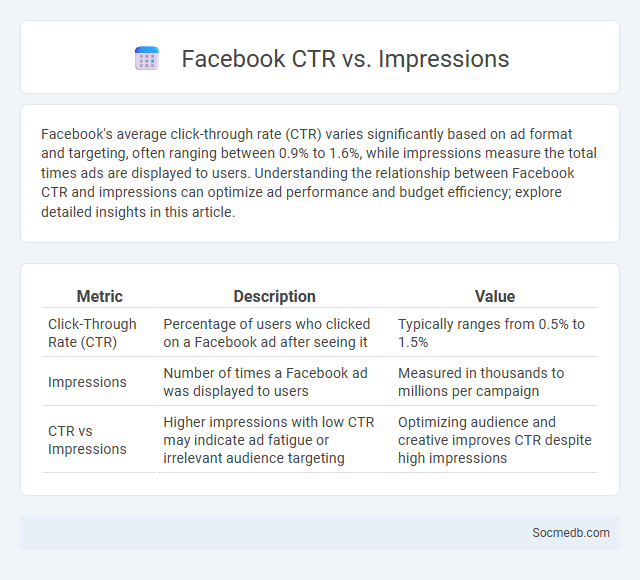
Photo illustration: Facebook CTR vs Impressions
Facebook's average click-through rate (CTR) varies significantly based on ad format and targeting, often ranging between 0.9% to 1.6%, while impressions measure the total times ads are displayed to users. Understanding the relationship between Facebook CTR and impressions can optimize ad performance and budget efficiency; explore detailed insights in this article.
Table of Comparison
| Metric | Description | Value |
|---|---|---|
| Click-Through Rate (CTR) | Percentage of users who clicked on a Facebook ad after seeing it | Typically ranges from 0.5% to 1.5% |
| Impressions | Number of times a Facebook ad was displayed to users | Measured in thousands to millions per campaign |
| CTR vs Impressions | Higher impressions with low CTR may indicate ad fatigue or irrelevant audience targeting | Optimizing audience and creative improves CTR despite high impressions |
Understanding Facebook CTR: Definition and Importance
Facebook CTR (Click-Through Rate) measures the percentage of users who click on your ad after seeing it, reflecting engagement and ad relevance. A high CTR indicates effective targeting and compelling content, directly impacting your campaign's return on investment (ROI). Monitoring and optimizing your Facebook CTR helps improve ad performance and drive more meaningful interactions with your audience.
What Are Impressions on Facebook?
Impressions on Facebook represent the total number of times a post or ad is displayed on users' screens, regardless of whether it was clicked or not. This metric helps marketers measure content visibility and gauge audience exposure across the platform. Tracking Facebook impressions enables businesses to optimize campaigns, improve brand awareness, and increase engagement rates effectively.
The Relationship Between Impressions and CTR
Impressions indicate how many times your social media content is displayed, serving as a key metric for visibility measurement. The click-through rate (CTR) reflects the ratio of users who engage by clicking links or actions relative to the total impressions, directly influencing campaign effectiveness. Understanding this relationship helps optimize content strategy to boost engagement and maximize your return on investment.
How Click-Through Rate Impacts Facebook Campaigns
Click-through rate (CTR) directly influences Facebook campaign performance by determining the relevance and engagement level of your ads to the target audience. A higher CTR signals to Facebook's algorithm that your content resonates well, potentially lowering ad costs and increasing reach. Optimizing CTR can boost your ad's visibility, ensuring your marketing budget delivers maximum return on investment.
Key Differences: CTR vs Impressions
CTR (Click-Through Rate) measures the percentage of users who click on your ad or post after seeing it, reflecting engagement quality, while impressions represent the total number of times your content is displayed, indicating reach and visibility. Your social media strategy needs to balance maximizing impressions to increase brand awareness and optimizing CTR to drive user interaction and conversions. Understanding these metrics helps tailor campaigns for both broad exposure and targeted responsiveness.
Tracking Click-Through Rate on Facebook Ads Manager
Tracking click-through rate (CTR) on Facebook Ads Manager provides critical insights into the effectiveness of ad campaigns by measuring the ratio of users who click on ads to those who view them. High CTR indicates strong audience engagement, relevance, and compelling ad creatives. Analyzing CTR trends helps optimize targeting strategies, ad placements, and budget allocation to maximize return on investment in social media marketing.
Strategies to Improve Facebook CTR
Optimizing your Facebook click-through rate (CTR) involves targeting your audience with precise segmentation and compelling, relevant ad creatives that match their interests and behaviors. Crafting strong calls-to-action (CTAs) and utilizing eye-catching visuals can significantly boost user engagement and increase CTR performance. Monitoring analytics and conducting A/B testing on ad formats, headlines, and images allows you to refine strategies and maximize the effectiveness of your Facebook campaigns.
Analyzing Impressions for Better Audience Insights
Analyzing impressions on social media platforms provides valuable insights into the reach and visibility of your content, helping you understand how many users have seen your posts. By examining impression data alongside engagement metrics, you can identify which types of content resonate most with your audience, allowing for more targeted and effective marketing strategies. Optimizing your social media campaigns based on impression analysis enhances your ability to connect with and grow your follower base.
Common Mistakes When Measuring Facebook CTR and Impressions
Misinterpreting Facebook CTR and impressions often leads to misguided ad strategies by overlooking factors like auto-play video views, which inflate impression counts without genuine engagement. Your measurement accuracy improves by differentiating between unique impressions versus total impressions to avoid skewed performance data. Properly analyzing both metrics assists in refining targeting and budget allocation for more effective social media campaigns.
Choosing the Right Metric: When to Focus on CTR vs Impressions
Selecting the right metric in social media depends on campaign objectives; click-through rate (CTR) is vital for measuring direct engagement and user action, indicating how effectively content drives traffic. Impressions are more suitable for brand awareness campaigns, revealing the total number of times content is displayed regardless of interaction. Prioritizing CTR helps optimize conversion-focused ads, while impressions gauge visibility and reach within target audiences.
 socmedb.com
socmedb.com